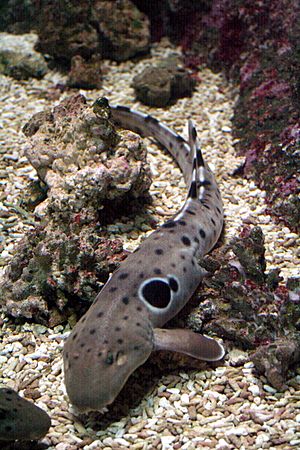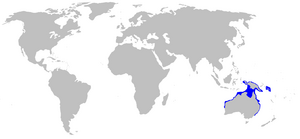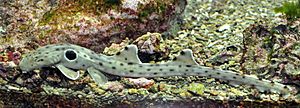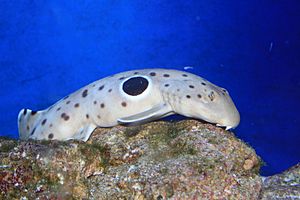Epaulette shark facts for kids
Quick facts for kids Epaulette shark |
|
|---|---|
 |
|
| Conservation status | |
| Scientific classification | |
| Genus: |
Hemiscyllium
|
| Species: |
ocellatum
|
 |
|
| Range of the epaulette shark | |
| Synonyms | |
|
Squalus ocellatus Bonnaterre, 1788 |
|
The epaulette shark (Hemiscyllium ocellatum) is a special type of shark that lives in shallow, warm waters near Australia and New Guinea. It belongs to the longtailed carpet shark family, Hemiscylliidae. This shark gets its name from the large, black spots with white edges behind each of its pectoral fins. These spots look a bit like the fancy shoulder decorations called epaulettes that military officers wear.
Epaulette sharks are usually small, growing to less than 1 meter (3.3 feet) long. They have a slim body, a short head, and wide, paddle-shaped fins. More than half of the shark's body length is its long tail section, called the caudal peduncle. Adult epaulette sharks are light brown with darker spots and faint stripes.
These sharks are active at night and often hang out in shallow areas like coral reefs or tidal pools. They have amazing ways to survive when oxygen levels drop very low in these pools. Instead of swimming, epaulette sharks often "walk" by wiggling their bodies and pushing themselves along with their strong fins. They eat many small creatures that live on the seafloor, like invertebrates and small bony fishes. Female epaulette sharks lay pairs of egg capsules about every two weeks from August to December. Because they are tough and don't get too big, epaulette sharks are popular in both public aquariums and home fish tanks. The International Union for Conservation of Nature (IUCN) says this species is of "Least Concern" for conservation, meaning it's not currently endangered.
Contents
What is an Epaulette Shark?
The epaulette shark was first described in 1788 by a French naturalist named Pierre Joseph Bonnaterre. He called it Squalus ocellatus. Later, its name was changed to the one we use today, Hemiscyllium ocellatum. The first shark studied was a young male, about 35 centimeters (14 inches) long, found near Cooktown, Queensland, Australia.
Some other names for this shark are the itar shark and the blind shark. However, "blind shark" is also used for a different species, Brachaelurus waddi. Scientists have studied the body shapes of carpet sharks, but they haven't fully figured out the exact family tree of the Hemiscyllium genus yet.
Where Epaulette Sharks Live
Epaulette sharks are found from the southern coast of New Guinea down to the northern coast of Australia, even as far south as Sydney. A very large group of these sharks lives in the Capricorn-Bunker Group of the Great Barrier Reef. Thousands of them are thought to live around Heron Island alone. There have also been reports of these sharks in Malaysia, Sumatra, and the Solomon Islands, but these sightings are not fully confirmed.
These sharks live in shallow waters, usually no deeper than 50 meters (160 feet). You can often see them in water that's barely deep enough to cover their bodies. They like tidal pools, flat coral areas, and places with staghorn coral.
What Epaulette Sharks Look Like
The epaulette shark has a long, slender body. More than half of its length is its thin tail section. Its snout is short and round, with its nostrils almost at the very tip. It also has two tiny barbels (whisker-like feelers) and grooves running from its nostrils to its mouth.
This shark has 26 to 35 rows of teeth in its upper jaw and 21 to 32 rows in its lower jaw. The teeth are small, with wide bases and pointed tips. Its eyes are oval and stick out a bit, with a large breathing hole called a spiracle below each eye. It has five pairs of small gill slits, with the fourth and fifth very close together.
The pectoral and pelvic fins are wide, rounded, and very muscular. The two dorsal fins (on its back) are about the same size and are placed far back on its body. The anal fin is low and sits just in front of the caudal fin (tail fin). The tail fin only has an upper part, which has a noticeable notch near the tip and is angled almost flat with the body.
Adult epaulette sharks are beige to brownish on top. They have many brown spots spread out and faint darker bands. The most noticeable feature is the very large black spot, ringed in white, behind each pectoral fin. These spots are why it's called the epaulette shark. Young epaulette sharks have alternating light and dark bands on their bodies and fins. These bands break up as the shark grows older. Epaulette sharks are typically 70 to 90 centimeters (27 to 35 inches) long. The longest one ever reported was 107 centimeters (42 inches).
How Epaulette Sharks Live
Epaulette sharks have a unique way of moving around their complex reef homes. They seem to "walk" by bending their bodies from side to side and pushing off the ground with their paddle-shaped pectoral and pelvic fins. This walking style is similar to how salamanders move. The shark can swim, but it often prefers to walk along the sandy or coral bottom, even when the water is deep enough to swim freely.
The bones in the epaulette shark's paired fins are different from other sharks. They are smaller and separated, which allows the fins to rotate and be used like legs. This way of moving even lets the shark crawl out of the water to reach isolated tidal pools. Scientists think this walking ability might be similar to how the first land animals moved.
Epaulette sharks are mostly active at night and are busiest when the water is low. They often hide inside or under coral heads. Sometimes, they sit out in the open on sandy areas or on top of reefs, facing the current. This helps them breathe better or be more aware of predators.
Larger fish, including other sharks, sometimes eat epaulette sharks. Their spotted coloring helps them camouflage (blend in) with their surroundings. The large "epaulette" spot might also act as an eyespot to confuse or scare away predators.
Epaulette sharks often have tiny parasites called gnathiid isopods. These larvae feed on blood and usually attach to the skin around the shark's cloaca and claspers. They can also be found inside the mouth and on the gills. These parasites usually don't cause much harm to the shark's health.
Surviving Without Oxygen
At night, the shallow reef areas where epaulette sharks live can become cut off from the ocean when the tide goes out. The amount of dissolved oxygen in these isolated pools can drop by 80% or more overnight. This happens because all the creatures in the pool use up the oxygen.
The epaulette shark has developed amazing ways to deal with these low-oxygen conditions. It can survive for over three hours in water with only 5% of the normal oxygen level without losing its ability to respond. In lab tests, epaulette sharks have survived for an hour with no oxygen at all, even at warm temperatures (30°C or 86°F). This is very unusual, as most animals that can handle low oxygen do so in cold temperatures.
When oxygen levels are low, the shark's heart rate and breathing slow down a lot. Its blood pressure drops by half as its blood vessels widen to send more blood to its brain and heart. Unlike many other animals, its blood flow stays steady, and its blood sugar levels don't go up. The brains of sharks use less energy than those of bony fish. The epaulette shark can lower this energy need even more by reducing the activity in certain parts of its brain. For example, it keeps its senses working but slows down the parts that control movement. This allows the shark to get enough energy to keep its brain cells alive while still being aware of its surroundings.
Temperature and Climate Change
The speed at which epaulette sharks grow and how healthy they are depends a lot on the temperature during their development. Rising temperatures due to climate change can make these sharks weaker. This could harm the entire ocean ecosystem.
What Epaulette Sharks Eat
The epaulette shark is an opportunistic hunter. This means it eats whatever small creatures it can find on the seafloor, such as crustaceans, worms, and small bony fish. Around Heron Island, more than 90% of an epaulette shark's diet is made up of polychaete worms and crabs. Young sharks mostly eat worms, while adults mostly eat crabs.
Epaulette sharks hunt most actively at dawn and dusk, but they can feed at any time of day. They mainly use their sense of smell (olfaction) and their ability to detect electrical fields (electroreception) to find hidden prey. They can suck prey into their mouths by expanding their muscular buccal cavity (mouth area). When looking for food, the epaulette shark sometimes flips over debris with its snout or pushes its head into the sand. It swallows the food and pushes the sand out through its gill slits.
Unlike most sharks, the epaulette shark might chew its food for 5 to 10 minutes. Its teeth can flatten to create a surface for crushing prey with hard shells.
Reproduction and Life Cycle
Mating for epaulette sharks usually happens from July to December. However, in aquariums, they can reproduce all year round. Sometimes, the female shark will follow and bite the male to start courtship. The male then grabs the female's pectoral fin with his mouth and lies next to her. He then inserts one of his claspers (reproductive organs) into her cloaca. Mating lasts about one and a half minutes.
Epaulette sharks breed easily in aquariums, even in tanks as small as 510 liters (135 gallons). However, larger tanks are better to give the baby sharks enough space. This species is oviparous, meaning the females lay eggs. They lay eggs from August to December. The female lays two (sometimes four) egg capsules at a time, every 14 days. She can produce a total of 20 to 50 eggs each year. Each egg case is about 10 centimeters (3.9 inches) long and 4 centimeters (1.6 inches) wide.
The young sharks hatch after 120 to 130 days. They are about 14 to 16 centimeters (5.5 to 6.3 inches) long when they emerge. The young sharks grow slowly at first, but after three months, their growth speeds up to about 5 centimeters (2 inches) per year. Both male and female epaulette sharks become able to reproduce when they are about 54 to 64 centimeters (21 to 25 inches) long. This usually happens when they are at least seven years old.
Epaulette Sharks and Humans
Epaulette sharks are generally harmless to humans. However, if you handle them, they might nip you. They are easy to see and handle for people on the beach because they move slowly out of the water and don't seem to be afraid of humans. Unfortunately, the sharks are often injured during these encounters.
This species adapts well to living in captivity. Many public aquariums in the United States, Canada, and Australia display them. One expert, Scott W. Michael, even called the epaulette shark "the best shark for the home aquarium." They will breed in captivity, even in tanks as small as 510 liters (135 gallons). However, full-grown sharks are best kept in tanks of 680 liters (180 gallons) or more. They should not be kept with other fish in a community tank, as they might eat them.
The International Union for Conservation of Nature (IUCN) has listed the epaulette shark as of "Least Concern." This means it's not currently at high risk of extinction. This species is common in Australian waters. It is not usually caught by either commercial or recreational fisheries. It is also not greatly affected by being collected for the aquarium trade or by being accidentally caught as bycatch in other fisheries. Much of its habitat in Australia is protected by marine parks.
However, off New Guinea, the epaulette shark is considered "Near Threatened." In this area, it faces problems like habitat degradation (when its home is damaged), destructive fishing practices, and too much fishing by local fishers.
In 2015, the behavior of an epaulette shark was filmed in detail by the BBC for a new documentary series called Shark. This documentary showed the epaulette shark's amazing ability to walk over land and how it hunts when the tide goes out.
See also
 In Spanish: Pintarroja colilarga ocelada para niños
In Spanish: Pintarroja colilarga ocelada para niños





